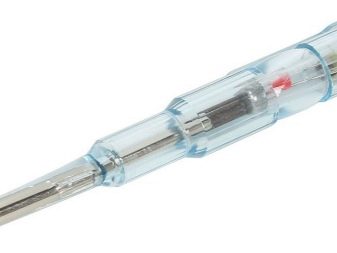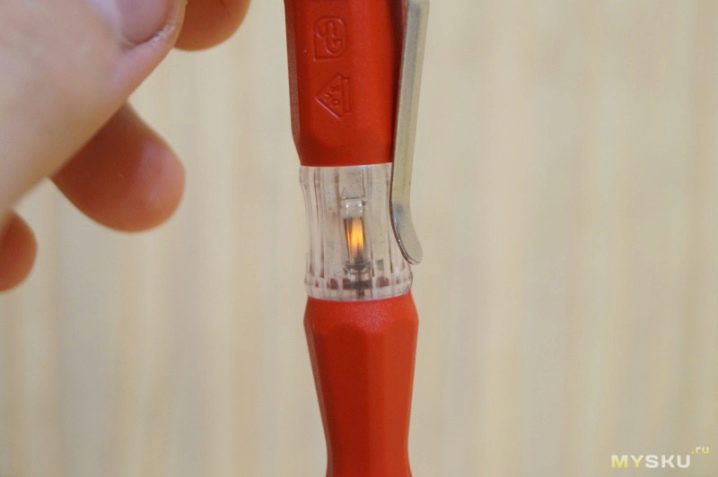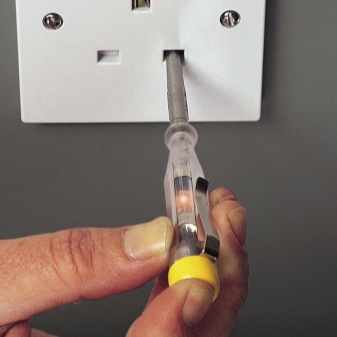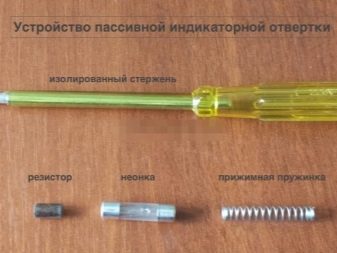How to determine the phase and zero with an indicator screwdriver: instructions and precautions

Problems with electrical wiring and electrical appliances these days are commonplace, which should be easily solved by every self-respecting man who does not even have the appropriate technical education. It should be said that this is possible due to the existence of a mass of auxiliary devices for troubleshooting electrical wiring. And knowing the basics of how electrical wiring and basic devices of this type are arranged, you can easily solve many problems. For example, determine the zero and phase, or distinguish the phase from zero using a special indicator screwdriver.
Varieties and functions of screwdrivers
Outwardly, the device under consideration looks like the simplest screwdriver. The difference will be visible in the pen. In the considered version of this tool in the handle body there is a resistor connected to a sting made of metal. It is this that will act as a guide.
The presence of a resistive part allows you to reduce the current strength to a maximum, which makes it possible to use such a screwdriver as safely as possible. A light diode or a neon-based light bulb is also built into the frame of the device, which is connected to an external-type patch on the contact plate, which is located on the outside of the device. It turns out that the electricity goes through the probe and then through the resistor is reduced to such a level that its indicator is as safe as possible for work. This is the main aspect of using an indicator screwdriver.

If we talk about the categories of such screwdrivers, then the latest models on the market can find voltage in the core even through a clay, whitewash or plaster layer, which will be extremely convenient, because it will eliminate the need to break part of the wall to get directly to the wire.
In general, the algorithm of action of such tools is the same in most cases. Although there are differences that arise depending on the categories, models and implicit functions that a particular model with an indicator function has. It so happens that in terms of its functionality, such an indicator-type screwdriver can replace a number of fairly expensive equipment. For example, there are battery-powered solutions that allow you to check the integrity of the wires, even when they are de-energized and no current flows through them.


Such options will give the following information about the circuit, which is checked:
- the presence of a sound signal will make it possible to understand whether there is voltage in the circuit or it is absent;
- a digital display shows the voltage value, which is usually displayed in volts;
- the use of the screwdriver in question makes it possible to check the AC and DC circuit in household electrical appliances;
- set mains polarity;
- continuity of the electrical circuit by sound or light indication.


Important! Any indicator-type screwdriver will necessarily have a lower and upper voltage measurement limit. Going beyond these limits in almost 100% of cases will lead to malfunction and breakdown of the device.
Generally, there are two categories of this type of screwdriver.
- With a neon lamp. This option is common and its structure is described above. The advantage of such a solution will be low cost and simplicity. The disadvantage is the small voltage range that you can work with.As a rule, we are talking about the range from 90 to 380 volts. Yes, and the phase wire can be determined in this case only with direct electrical contact.


- With LED. The option with a signaling device on the LED will be slightly different. It should be noted here that for its power supply, the current strength in the usual scheme will be small. Therefore, a so-called time transformer is used. The diode will operate in pulsed mode. How many times the continuous glow will decrease, the same number of times the current force passing through the diode will rise.


Due to the presence of a limiting resistor, the probe is connected to a contact with different polarities at the diode bridge rectifier. And the second contact is brought out to the indicator handle so that you can touch it with your finger. The small constant that has arisen goes to the storage capacitor. After that, the avalanche type transistor is activated, which is activated according to the inverse circuit. At the end of all this, the LED receives a pulsating current. Such a screwdriver can carry out phase detection even at a voltage of 45 volts. And if you connect not a probe, but a small antenna, then you can easily find a variable-type electric field.
If we talk about the field of application, then with the help of such screwdrivers, you can perform the following types of work:
- check a phase conductor is connected to the socket or switch contact;
- if the outlet on the extension cord does not function, then you can check all the sockets using a probe;
- check where exactly the phase on the cartridge is connected: to the main contact or to the thread;
- find out if there is voltage in a certain electrical device;
- check how good the grounding conductor is.



How to check phase and zero?
Now let's go directly to checking the zero and phase. But before starting work of this type, you should check the performance of the device itself, so that it displays the correct data so that the desired actions can be taken by performing the following actions:
- first, you should carry out a visual inspection and make sure that the structure of the device is completely integral and does not have any mechanical damage;
- after performing this action, if no flaws are found, you should test the device;
- When checking, the probe should be inserted into both holes of the working socket, at the same time it is required to keep the thumb on the part of the handle of the dielectric sensor - if something is wrong, the indicator will not work;
- when using a solution with a neon-type indicator on a battery, you can pinch the screwdriver bit and the patch with your fingers; if the light diode is activated, this will mean the device is working properly.

Let's explain the definition of phase and zero on the most common outlet. You need to insert a screwdriver into one of the socket holes and, as described above, touch your finger to the handle plate. If the indicator is activated, it means that the phase was found. Then we insert the device into another hole - the activation of the light bulb should not occur. If everything is as it should be, it is zero.
If it even then glows from the neutral wire, which seems to be impossible, this means that there are two phases. You should not be afraid, because this is possible if the contact on the zero cable simply disappeared. For example, it could happen in a box somewhere. There can be no two phases in the outlet in any way: one will simply go into the second hole through some switched on electrical appliances (light bulbs, washing machines, refrigerators, and so on).
It should be noted that quite often many people confuse a simple indicator screwdriver with a dial version. In the second case, the screwdrivers have a battery. If using such a screwdriver to carry out the determination of the ground, then there is no need to touch the heel. Or the light will be active, as in the case of touching the phase, as well as when touching zero.


Security measures
If you will be working with an indicator type screwdriver, you should know the following rules:
- in no case should you use a screwdriver without a screw;
- only the battery can be removed from the device and nothing else;
- when replacing the battery, the screw should be tightened as tightly as possible, which is done clockwise;
- it is forbidden to use a device that has mechanical damage;
- do not use a screwdriver in high humidity;
- it is extremely dangerous to use it in networks with inappropriate voltage standards.




It will not be superfluous to remember the following basic safety measures when working with wiring:
- do not grab the instrument probes by the bare parts to avoid electric shock;
- in no case should you look for wiring with your bare hands - you must do this with rubber gloves and have shoes with rubber soles;
- hands should also be dry;
- sometimes resistance, not voltage, can be measured to indicate zero and ground; you should be extremely careful in this case.


This is a series of fairly simple rules, but their strict and precise implementation will guarantee the preservation of health and safety at work. But in general, as you can see, it is very easy to determine the phase and zero with an indicator screwdriver. The main thing is to follow the safety rules and principles of working with electrical appliances, as well as with power grids.
How to determine the phase and zero with an indicator screwdriver, see the video below.













The comment was sent successfully.